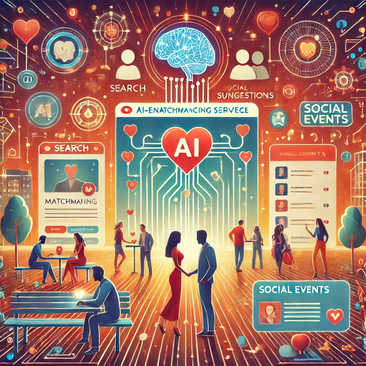Project Goals
The goal of the project was to enhance the performance and scalability of a popular dating service by rewriting its search and recommendation services. The original system was developed using Ruby on Rails, which was sufficient for the initial launch but struggled to handle increased user load as the platform gained popularity. Migration to Go was identified as the best solution to address these performance issues.
Functional Features
- Enhanced Search System: The service includes advanced search functionality that allows users to specify preferences such as age, location, interests, and more. Optimizing this feature aimed to reduce response times and improve user experience.
- AI-Driven Matchmaking: Users describe their ideal partner, and the AI matches them with suitable candidates. This matchmaking is based on detailed user profiles and psychological tests designed by experts.
- Recommendation Engine: The recommendation engine suggests matches based on compatibility scores derived from personality tests and user preferences. The improved engine now handles high volumes of data more efficiently, providing users with accurate recommendations without delay.
- Social Events Integration: Users are also encouraged to participate in social activities, such as concerts, sports events, and educational gatherings. The event recommendation feature was designed to help users meet like-minded individuals in a variety of settings beyond traditional dating.
- AI-Organized Meetings: After a successful match, the AI arranges a meeting in a secure location, and users are encouraged to share their experiences post-meeting. This feature required seamless integration between user communication and scheduling services.
Solution Concept
The existing Ruby on Rails backend was unable to keep up with the growing user base, which led to performance bottlenecks during peak hours. The primary focus was on migrating the core components to Go to take advantage of its superior performance, especially for concurrent processes.
Key Technical Improvements:
- Language Migration: The migration from Ruby on Rails to Go provided improved concurrency and better resource management, which are crucial for handling the high number of concurrent users in a dating platform.
- Containerization with Docker: The application was containerized using Docker to simplify the deployment process and make the platform more scalable. This approach allowed for flexible scaling based on the current load.
- RESTful API Development: A new RESTful API was developed to facilitate communication between different services, including the search engine, matchmaking algorithm, and event management features.
- Database Optimization: PostgreSQL was maintained as the database solution, with optimizations to better handle complex queries related to user preferences and match suggestions.
Results
- Significant Performance Boost: Migrating to Go resulted in up to a 60% reduction in response times, significantly enhancing user experience.
- Scalable Infrastructure: The use of Docker containerization allowed for more efficient scaling of services, ensuring the platform could handle peak loads without compromising performance.
- Increased User Engagement: The optimization allowed for faster matches and improved service reliability, leading to increased user retention and engagement. Users could now easily explore matches and participate in social events without delays.
- Reduced Operational Costs: The migration also led to reduced server costs due to Go's efficient resource management, which allowed the platform to handle more users with fewer hardware resources.
Technology Choices Justification
- Go: Go was chosen for its simplicity and excellent concurrency capabilities. It is particularly well-suited for scenarios where high performance and efficient handling of multiple simultaneous requests are needed.
- PostgreSQL: Continued use of PostgreSQL ensured data integrity and supported complex relationships between users, preferences, and match histories.
- Docker: Docker was utilized for deploying microservices to ensure ease of scalability and maintain modularity in the application.
- Linux: The platform was built on Linux due to its reliability, stability, and cost-effectiveness for running production-grade applications.
User Use Cases
- Matching Users for Romantic Dates: Users enter specific preferences, and the system suggests potential matches using AI. The matchmaking process is now much faster, allowing users to get instant recommendations.
- Participating in Events: Beyond dating, users can join various events, such as concerts or social gatherings, where they can meet other users with shared interests. This feature also helps build a broader community.
- Psychological Compatibility Tests: Users can take psychological tests, which the system uses to generate compatibility scores, leading to more meaningful matches.
Development and Testing Approach
The development was carried out using Agile methodology, allowing the team to incorporate continuous feedback and ensure alignment with user expectations. Performance testing was a key component, with focus on:
- Load Testing: Simulated high user traffic to ensure the system could handle increased loads.
- Unit and Integration Testing: Focused on ensuring that each microservice worked as intended and integrated seamlessly with other components.
Security Measures
- User Data Protection: Encryption was applied to sensitive user data to ensure privacy and security.
- Secure Meeting Locations: AI-suggested meeting spots were evaluated to provide safe environments for users.
Client Benefits
- Scalable Performance: The platform is now able to handle significantly more concurrent users, ensuring that even during peak times, users can find and connect with matches seamlessly.
- Enhanced User Experience: The faster and more reliable service has improved user satisfaction, leading to a higher rate of subscriptions and positive feedback.
- Community Building: The addition of social events as part of the matching process has enhanced the platform's appeal, encouraging more diverse user interactions.
User Feedback
User feedback indicated a significant improvement in matchmaking speed and accuracy, as well as higher satisfaction with the new event-related features. The migration to Go and improved infrastructure were key factors in enhancing the overall experience.
